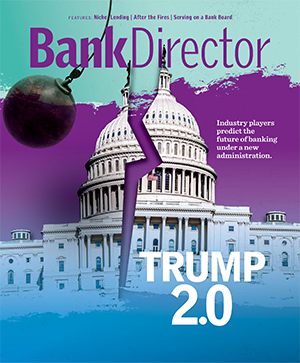
2020’s Growth All-Stars
Low interest rates pressured net interest margins in 2020, but they also produced outsized growth for banks with a strong focus on mortgage lending.
“From a nominal – that is, not inflation-adjusted perspective – [2020] was the biggest year in the history of the [mortgage] industry, and it was driven heavily by the fact that mortgage rates fell to 2.5%” for customers with good credit history, says Douglas Duncan, senior vice president and chief economist at Fannie Mae. Single-family mortgage originations totaled $4.54 trillion, he says. Almost two-thirds were mortgage refinancing loans; the remaining loans were used for purchases. His tally represents an estimate – the U.S. government doesn’t calculate total mortgage loan volume.
But Duncan’s estimation is reflected in the countless press releases I’ve read from banks boasting record mortgage volume – and revenues – over the past few months. And mortgages are a major factor that fueled 2020 growth for the fastest-growing banks.
Using data from S&P Global Market Intelligence, Bank Director analyzed year-over-year growth in pre-provision net revenue (PPNR) at public and private banks above $1 billion in assets to identify the banks that have grown most quickly during the pandemic. We also included return on average assets, calculated as a three-year average for 2018, 2019 and 2020, to reward consistent profitability in addition to growth. The analysis ranked both factors, and the numeric ranks were then averaged to create a final score. The banks with the highest growth and profitability had the lowest final scores, meaning they ranked among the best in the country.
Among the best was eighth-ranked $2.4 billion Leader Bank. President Jay Tuli credits low interest rates with driving outsized growth at the Arlington, Massachusetts-based bank. Its sizable mortgage operation helped it to take advantage of demand in its market, roughly doubling mortgage volume in 2020 compared to the previous year, says Tuli.
“With rates coming down during Covid, there was a big surge in mortgage demand for refinances,” explains Tuli. Most of those mortgage loans were sold on the secondary market. “That produced a substantial increase in profitability.”
Mortgage lending also significantly lifted revenues at Kansas City, Missouri-based NBKC Bank, according to its chief financial officer, Eric Garretson.
The $1.2 billion bank topped our ranking, and it’s one of the two banks in this analysis that have become specialists of sorts in banking-as-a-service (BaaS). The other is Celtic Bank Corp., which is also a Small Business Administration lender that funded more than 99,000 Paycheck Protection Program loans.
NBKC’s BaaS program grew in 2020, says Garretson, though “this was dwarfed by the increase in revenue from mortgage lending.” Right now, NBKC focuses on deposit accounts, allowing partner fintechs to offer these accounts under their own brand, issue debit cards and deliver similar banking services. Lending products are being considered but aren’t currently offered, says Garretson.
As the financial technology space continues to grow, the opportunities should increase for banks seeking to partner with fintech companies, says Alex Johnson, director of fintech research at Cornerstone Advisors. Banks like NBKC and Celtic Bank Corp. have developed the expertise and skills needed to partner with these companies. They also have a technology infrastructure that’s fintech friendly, he explains, allowing for easy integration via standard, defined application programming interfaces (APIs) and a microservices architecture that’s more modular and decentralized. Put simply – a good BaaS bank will have the same tech capabilities as its fintech client.
“There’s a very clear model for how to do this, and there’s growing demand,” says Johnson. “One thing that tends to characterize banks that do well in the banking-as-a-service space are the ones that build a specialization in a particular area.” These banks have a track record for building these products, along with the requisite processes and contracts.
“When a company comes to them, it’s as easy [a process] as it could possibly be,” says Johnson. “The more of that work they do, the more that ripples back through the fintech ecosystem. So, when new fintech companies are founded, [and venture capitalists] are advising them on where to go – they tend to point to the banking-as-a-service partners that will work well.”
Top 10 Fastest-Growing Banks
| Bank Name/Headquarters | Total Assets (millions) | ROAA 3-year avg. |
PPNR growth YoY | Score |
| NBKC Bank Kansas City, MO |
$1,207.5 | 7.93% | 67.52% | 14.67 |
| Plains Commerce Bank Hoven, SD |
$1,129.9 | 3.97% | 86.75% | 15.33 |
| The Federal Savings Bank Chicago, IL |
$1,076.2 | 7.66% | 60.37% | 19.67 |
| Northpointe Bank Grand Rapids, MI |
$3,685.5 | 2.58% | 73.24% | 25.00 |
| Celtic Bank Corp. Salt Lake City, UT |
$4,704.8 | 4.22% | 55.87% | 28.00 |
| Union Savings Bank Cincinnati, OH |
$3,586.3 | 2.75% | 56.76% | 29.67 |
| North American Savings Bank, F.S.B. Kansas City, MO |
$2,470.9 | 2.71% | 58.57% | 30.67 |
| Leader Bank, N.A. | $2,419.6 | 2.46% | 61.63% | 32.67 |
| Waterstone Financial Wauwatosa, WI |
$2,198.0 | 2.41% | 59.23% | 38.00 |
| BNC National Bank Glendale, AZ |
$1,225.7 | 2.13% | 71.44% | 39.33 |
Source: S&P Global Market Intelligence. Total assets reflect first quarter 2021 data. Average three-year return on average assets reflects year-end data for 2018, 2019 and 2020 for the largest reporting entity. Year-over-year pre-provision net revenue (PPNR) growth reflects year-end data for 2019 and 2020. Bank Director’s analysis of the fastest-growing banks ranked PPNR growth and average ROAA at banks above $1 billion in assets; scoring reflects an average of these ranks.



